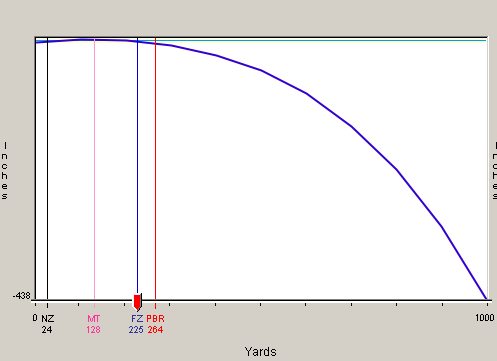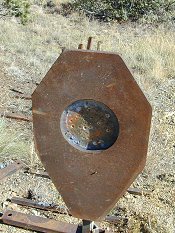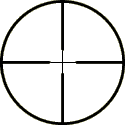 |
|
Typical bullet path. Note how the steepness of the trajectory increase the farther out you get. |
Ranging, or the estimation of the distance to a target, is of utmost importance to a shooter because once ranges get a little past the maximum point blank range, or about 250 yards for most ammunition, the curve of a bullet's trajectory becomes steeper and steeper and small differences in distance drastically affect the point of impact. (Refer to the article on zeroing for information on obtaining the maximum point blank range.)
As an example of how the drop increases past the point blank range the following are the results from a 165 gr flat based .30 caliber bullet at 2700 f/s zeroed at 225 yards. From this table you can see how the trajectory becomes steeper as the range increases. If you are off in your range estimation it becomes increasingly harder to hit things as the range gets longer.
| From/To |
Bullet path change |
| 200 - 300 | -8 |
| 300 - 400 | -16 |
| 400 - 500 | -27 |
| 500 - 600 | -38 |
| 600 - 700 | -52 |
| 700 - 800 | -70 |
| 800 - 900 | -100 |
| 900 - 1000 | -120 |
 |
|
Typical bullet path. Note how the steepness of the trajectory increase the farther out you get. |
While laser range finders are now all the rage, and even the less expensive ones are quite good, they suffer from several draw backs. First they are fairly expensive with prices starting around $300 for a good unit and going upward to several thousand dollars, so many people still don't have them. Second they use batteries and as we all know batteries have a habit of dying when you least expect them to (usually when there isn't a spare set for miles). Third, target discrimination ability can vary greatly on small or not very reflective targets. Fourth, in rain, snow, or fog their accuracy and reliability suffers. I have noticed that the accuracy and discrimination of hand held range finders is greatly increase by mounting them on a stand or tripod, rather than hand holding them.
Now this doesn't mean that the technology isn't good. Use the technology when it provides an advantage, but don't become dependent upon it. Have a low tech alternative available. (It goes without saying that you have to be reasonably proficient in the low tech mode.)
Visually estimating ranges can be very misleading due to the type of terrain or lack of comparative objects, especially when the observer doesn't know the actual size of the object being viewed, and many people have no concept of just how far away 500 yards, or even 300 yards is. Most of those "500 yard" shots everyone seems to brag about turn out to be under 200 yards when actually measured.
Try this some time. Find a BIG clear field or a long straight road. Have someone stand somewhere and then measure or pace off an honest 300 - 500 yards. Or, on a long straight road set your odometer to 0 and then drive. Every 1/10 mile is 176 yards so drive 2/10 (352 yards) or 3/10 of a mile (528 yards). Turn around and see just how far away they are. That's a L-O-N-G way off, eh? Then try it in an area where there are a lot of bushes with your friend standing in the bushes--then have him wear something that even slightly blends in with the surroundings. Even when you know where a target is located in a cleared area most folks have a hard time seeing anything. Imagine how difficult things get in a bushy area when the target is not distinct, and its exact location and distance is not known.
Tests conducted by the US military showed just how difficult it is to even see targets in the field. The chart below shows the likelihood of seeing a standing humanoid target as a function of range under field conditions. It is based upon data developed by the Army Operations Research Office during project SALVO.
 |
|
Likelihood
of seeing standing humanoid target vs. range |
As an example of how difficult it is to estimate range even on a known size target consider this. On the Cooper Game-Walk rifle range at NRA Whittington Center many experienced people over-estimate the distances to the targets which are basically elongated metal octagons, 14" x 24", which can be place vertically or horizontally. The center hole is 7" and has a swinging flapper which indicates a center hit. While several of the targets are available for close up inspection many people think that the farthest targets are well over 200 yards with most estimates close to 300 yards. Lasing the targets showed that the far target was just under 225 yards and the closest one about 50 yards.
 |
Luckily, with a proper zero most people at least hit the targets but not necessarily dead center even when they misjudge the range out to about 300 yards but one may not always be able to count on that, especially under windy conditions where the range to target has a great impact on wind induced drift.
The other "in" thing these days are portable "ballistic computers." These devices claim to take the work out of shooting. However there are some big caveats. First, if they don't allow for multiple drag models (G1, G5, G6, G7, or custom), or allow the use of "DRG" radar range files they will still not be 100% accurate. (See the "External Ballistics" page on this site). Second, what happens if your batteries suddenly die, the computer hardware goes south, or the unit gets dropped or "fragged?" Without knowing the basics you will be toast.
Probably the best way to learn range estimation is to view life size representations of your intended targets at various known ranges under different conditions. Coupled with a knowledge of the subtensions of your scope's reticle knowing your targets approximate size can help you estimate ranges. There are also several reticle designs made specifically for range estimation.
As an example, lets assume that the manufacturer of your scope says that the specifications at a given power are: thick lines = 2" (2 MOA) at 100 yards, the thin lines = 1" (1 MOA), and the distances between the posts are 12 MOA.

With a fixed power scope if you know that a given area of your target is, say, 18 inches wide and it fits just inside the space between the center of the cross hairs and the end of a thick post on your reticle (12" at 100 yards) your target is about 150 yards away.
Actual range = 100 * [target
measurement] / [measurement covered by the target's reticle space at 100
yards]
= 100 * 18 / 12
= 150
As another example, suppose the target fits in one half of space between the thin vertical line and the thick horizontal post. In this case, plugging in the numbers:
100 * 18 / 6 = 300
so your target is about 300 yards away.
Now of course, this is a fairly rough estimate since you may not accurately measure the space on the target covered by the reticle but it will at least help to verify that a given target is close to a particular range, and at least you won't be holding for 500 yards when your target is only at 300. Many variable scopes have reticles so dimensioned that you can use the variable power function to help estimate ranges in a similar fashion. See your instruction book for details. "Mil-Dot" reticles function in the same way but in the interest of keeping things short I leave it to the reader to research mil-dot reticle use.
If you are using a typical variable power scope the subtension's dimensions change as the magnification changes. The formula below gives the dimension change
DA = Stated dimension at stated magnification
DB = Dimension at new magnification
MA = Stated magnification
MB = New magnificationDB = (MA/MB) * DA
As an example, if the reticle dimension at 4X is 1.5 MOA and you reset the magnification to 9X, then
DA = 1.5
MA = 4
MB = 9DB = (4/9) * 1.5 = .66"
You can also use life sized paper and 3-D game targets as great training aids. To improve your ranging ability you can set up a training field to practice range estimation by having someone place representative targets at various ranges known only to them. (Have them either carefully physically measure the distances or borrow a laser range finder from someone) and then try to figure the actual ranges to the targets. Chance are that if you have not done this before you will visually over estimate the target distances unless you range them with your scope, a laser, or are very lucky.
Some target sources include:
http://www.biggameproshop.com/mckenzie-exotic.htm
http://www.sportsauthority.com/family/index.jsp?categoryId=856186&cp=712508.715301
http://www.mckenziesp.com/target_store/
http://www.turkeyhuntingsecrets.com/store/store-targetspaperdept.htm
Black Bear, Coyote, Javelina, Mule Deer, Pheasant, Pronghorn, Red Fox, Whitetail Deer, Duck, Groundhog, Rabbit, Squirrel, and Turkey life sized targets may also be obtained from:
National Rifle Association Sales Department
P.O. Box 5000
Kearneysville, WV 25430-5000
1-800-336-7402
You can also try your local archery shop.
I also have a zipped MS Word document with a drawing of a deer on a grid available. Just enlarge the drawing so that the grid is 1' x 1' and then make your life sized deer targets. Click here to download deer.zip. I also have an zipped MS Word document with some dimensioned drawings of various animals and a chart that you can use at 5 feet to see what various animals look like at different ranges. Click here to download ranging.zip. Humanoid targets can be made using a standard 18" x 30" IPSC or IDPA silhouette target mounted on a lower body as shown below
|
|
Fun With Ranging
If you are interested in having some fun with ranging, set up a bunch of life-sized targets (trimmed to the outline of the game) in a field mixed in with bushes and trees, at various ranges (measure or laser them) known only to you, and then invite your buddies to come over and estimate the ranges to the various targets (no laser rangefinders allowed). Whoever gets the most correct or comes closest to the most targets wins some earth shaking prize. Whoever, is the farthest off from the correct distance of a given target has to go and retrieve that particular target, accompanied by appropriate hazing. If your ranging area is safe to shoot in, the winner gets to fire 1 (and just 1) shot at the target he properly (or most closely) ranged from a field position. If the "A" zone of the target is hit he gets a prize. If he misses the "A" zone, when everyone goes to lunch he can come but not eat. (After all, he "missed" his meal.)
If you really want to get those braggarts in your shooting club who claim they can hit way out there all the time, do this. Make a 8" - 10" circular target of a neutral color and put it out on a stake at some range between 300 and 500 yards in plain view. See how many can find and then hit it with the first shot, from a field position of their choice (no bipods or shooting benches) and with no warm up or sighters. Don't tell them the distance, just the size of the target and give them 1 try (2 if you are a nice guy) and if they miss (no excuses accepted since they are great shots), they owe you lunch. You may have to join a gym to lose all the pounds you'll gain.
Warning!
In keeping with Rule 2 (Don't point your firearm at anything you are not willing to destroy) you should not practice ranging by pointing at random objects other than on a "ranging range" or an area in which it is safe to shoot.
"Experts"
I hear about a lot of "experts" who claim to be able to hit targets way past 1000 yards every time, or who claim to have some magic accessory that will allow such hits with no effort. Frankly I don't believe it. I've had some people claim they could hit way out past Ft. Mudge but when they tried in my presence there was always "some problem" that interfered.
When I see someone pull their rifle (a real rifle and not some benchrest rail gun) out of the case, no sighters, and hit a 10" plate with the first round at 500 - 1000 yards or beyond, from any position on two separate days I'll believe it. Jeff Cooper had an open challenge with a cash reward at Gunsite for many years for someone to do something similar, but never had any takers.
To email me click here
| Back to the Ballistics Main Page | Back to Fr. Frog's Main Page |
Disclaimer
As far as I know all the information presented above is correct and I have attempted to ensure that it is. However, I am not responsible for any errors, omissions, or damages resulting from the use or misuse of this information, nor for your doing something stupid with it. (Don't you hate these disclaimers? So do I, but there are people out there who refuse to be responsible for their own actions and who will sue anybody to make a buck.)
Updated 2022-06-06 @ 1645